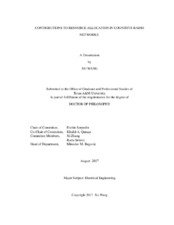| dc.description.abstract | The continuous increase in the number of wireless devices and the huge demand for higher data rates have promoted the development of new wireless communications technologies with improved spectrum sharing features. Recently, the concept of cognitive radio (CR) has gained increased popularity for the efficient utilization of radio frequency (RF) spectrum. A CR is characterized as a communication system which is capable to learn the spectrum environment through sensing, and to adapt its signaling schemes for a better utilization of the radio frequency resources. Resource allocation, which involves scheduling of spectrum and power resources, represents a crucial problem for the performance of CR networks in terms of system throughput and bandwidth utilization.
In this dissertation, we investigate resource allocation problems in a CR network by exploring a variety of optimization techniques. Specifically, in the first part of the dissertation, our goal is to maximize the total throughput of secondary users (SUs) in an orthogonal frequency division multiple access (OFDMA) CR network. In addition, the power of SUs is controlled to keep the interference introduced to primary users (PUs) under certain limits, which gives rise to a non-convex mixed integer non-linear programming (MINLP) optimization problem. It is illustrated that the original non-convex MINLP formulation admits a special structure and the optimal solution can be achieved efficiently using any standard convex optimization method under a general and practical assumption.
In the second part of the dissertation, considering the imperfect sensing information, we study the joint spectrum sensing and resource allocation problem in a multi-channel-multi-user CR network. The average total throughput of SUs is maximized by jointly optimizing the sensing threshold and power allocation strategies. The problem is also formulated as a non-convex MINLP problem. By utilizing the continuous relaxation and convex optimization tools, the dimension of the non-convex MINLP problem is significantly reduced, which helps to reformulate the optimization problem without resorting to integer variables. A newly-developed optimization technique, referred to as the monotonic optimization, is then employed to obtain an optimal solution. Furthermore, a practical low-complexity spectrum sensing and resource allocation algorithm is proposed to reduce the computational cost. | en |


